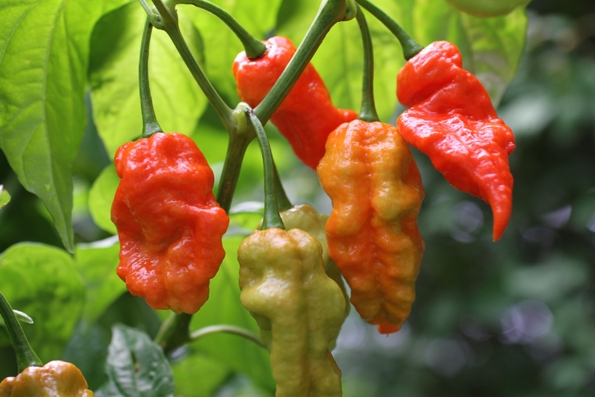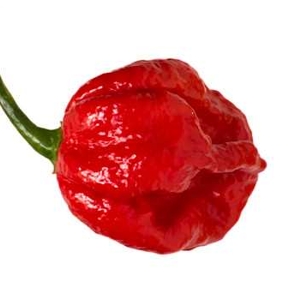The craze that peaked (at least in the mainstream media) a couple of years back, for eating ultra-hot Chili Peppers, seems to have passed off for the most part without anybody actually passing away as a result of participating. But those who’ve survived extreme Hot Pepper exposure tell horror stories…
 Naga Bhut Jolokia Peppers on the vine: Hottest Peppers Nature has been
Naga Bhut Jolokia Peppers on the vine: Hottest Peppers Nature has been
able to contrive. But man has stepped in to breed even hotter ones…
What’s makes Hot Peppers ‘hot’?
That’s easy. It’s capsaicin, a chemical compound found in all Chili Peppers that triggers the sensation of heat in your mouth. And other parts of your digestive tract. It’s an irritant which biologists theorize was originally selected for in Chili plants by evolution as a defense from being eaten.
But I’ve always wondered why some Chilies evolved to be so unbelievably hot. I mean, Jalapeños, at about 5,000 Scoville Units (the scale that measures Chili Heat) are plenty hot enough to satisfy the vast majority of folks who like hot food. So, why did evolution go nuts and create the Naga Bhut Jolokia (see picture, above), the world’s hottest naturally-occuring Pepper, which comes in at an an average of 1 million Scovilles? They’re called ‘Ghost Peppers’ for a reason, though it appears no one has actually diet (yet) from eating them. According survivors’ reports, they were never able to stand very much of the fiery fruit, and many failed to keep it down long enough for it to do any severe damage.
Why do people eat ultra-hot Peppers?
Even the people who sell the seeds for gardeners to grow their own ultra-hot Chili Peppers recommend against eating them. But some crazy people always do. I say they’re attention seekers, for the most part, though some are adventurers lured into small, formerly unknown restaurants by Chili eating contests that promise fame and, sometimes, financial rewards, but usually only a t-shirt, as a prize.
It’s been suggested that Chili eating contest participants – whether they’re closet masochists, exhibitionists or whatever – are willing to risk hours or even days of extreme discomfort, not to mention stomach and throat ulcers and other injuries to achieve their hazy goals.
What tortures have Hot Pepper eaters endured?
A passage from the background page at the website for Sandia Seed, which sells Carolina Reaper seeds (see: picture at top of page), recounts, too much capsaicin can cause alarming full-body consequences:
It’s not just the Reaper that can make you feel like you are dying. Ruari Barratt, a freelance journalist working in the UK, knows firsthand the effects of eating too much capsaicin after a burger laced in concentrated Piri Piri Chile Sauce from India sent him to the hospital. According to Barratt, he experienced agonizing pain in his mouth only moments after his first bite of the burger, and as time passed, the pain only worsened.
“Once whatever I’d managed to swallow reached my stomach (or however far inside me it got) my legs started convulsing and my hands seized up (I presume because I was hyperventilating),” Barratt wrote in an email to Medical Daily. “My eyes were rolling back in my skull, I was extremely pale, and it was hard to talk.”
Barratt’s experience lasted a total of three hours, and although he did not walk away with any lasting damage, it did feel like it was killing him.
Doctors have also coined a name for rapid-onset headaches caused by eating Hot Peppers: Thunderclap Headaches. They’re believed to be caused by severe vasoconstriction as a shock reaction to eating as little as one single ultra-hot Chili. Like Barratt’s symptoms, chronicled above, Thunderclap Headachaes usually only happen as a result of participation in Chili-Eating contests.
Would-be Chili challengers, take note…
So, what are ultra-hot Chilis really good for, anyway?
Seems they’re sought after by weapons developers to make new, improved Pepper Sprays and Chili Grenades. And, if you hold the patent for a new, super-ultra-hot artificially-bred Chili Pepper, it can make you rich.
Aside from the notoriety of being on record as the developer of the latest ‘World’s Hottest Chili Pepper’, that’s the practical reason people like Smokin’ Ed Curry of Fort Mill, SC, persist in breeding ever-hotter Peppers. Curry’s Reaper reigned only for a few months before a UK breeder based in St. Asapah, Denbighshire, claimed to have produced a 2.4 Scoville Pepper. And months after that, Curry struck back with an undated, enhanced Reaper X Pepper that clocked in at 3.1 Scovilles.
Ask folks who eat Chilies every day – Asians, Indians, Caribbean natives, Central and South Americans – how much heat they prefer, and they’ll probably tell you less is more. You want to taste the flavour after all, not sweat and squirm under the burden of the Scoville Units. Personally, I find Thai Chilies and other small Asian Chilies a touch hotter than I’d like. But I’m told that, if I ate them every day, I’d gradually move on up from Jalapeños to Thai Chilies and other slightly hotter ones which ‘the natives’ prefer. I’ll leave it up them to decide (and proclaim) where ‘eating perfection’ sits on the Scoville Scale…
~ Maggie J.

